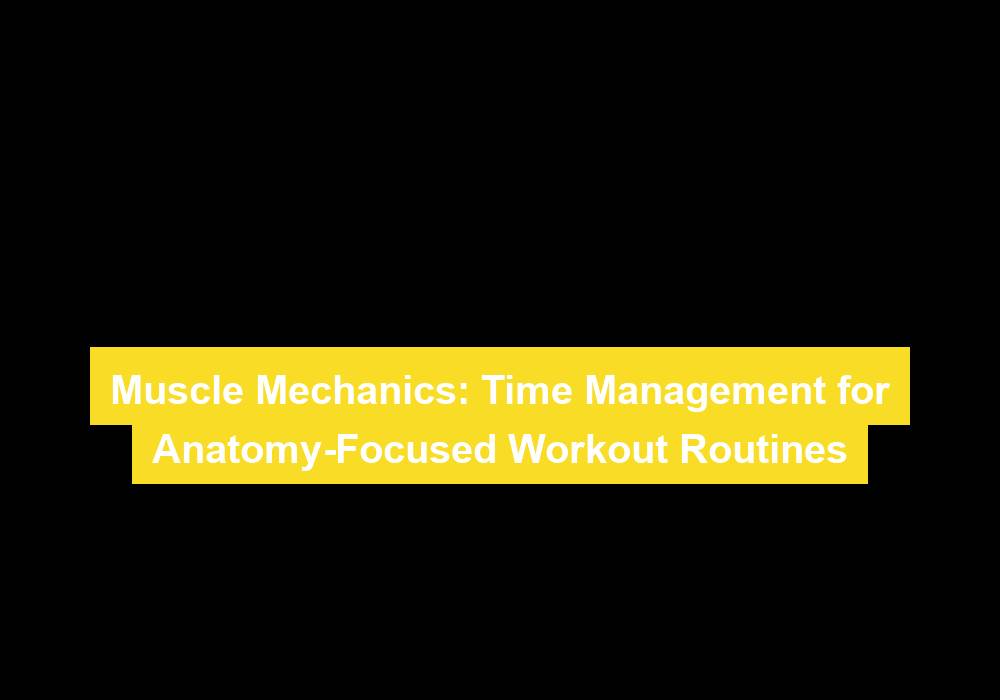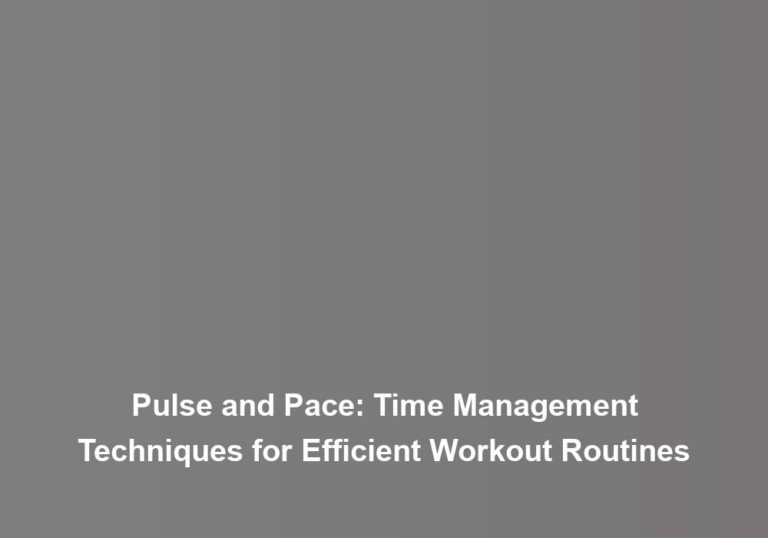Muscle Mechanics: Time Management for Anatomy-Focused Workout Routines
Are you struggling to find the right balance between focusing on specific muscle groups and managing your time effectively during your workouts? As you strive to attain your fitness goals, itG??s essential to optimize your exercise routine to target key muscle groups efficiently. By understanding muscle mechanics and implementing time-saving strategies, you can customize your workout plan for maximum results in minimal time. With an anatomy-focused approach, you can streamline your workouts and achieve your fitness goals more effectively.
Understanding Muscle Anatomy
To effectively design and execute targeted workout routines, it is essential to have a comprehensive understanding of muscle anatomy. Muscle anatomy is the foundation upon which all effective workout routines are built. Understanding the intricacies of muscle contraction, fiber types, muscle function, and joint movement is crucial in achieving optimal results from your workouts.
Muscle contraction is a fundamental process that underlies all movement. There are three main types of muscle contractions: concentric, eccentric, and isometric. Concentric contractions occur when the muscle shortens during contraction, such as when you lift a weight. Eccentric contractions happen when the muscle lengthens under tension, like when you lower a weight. Isometric contractions involve no change in muscle length, like when you hold a weight steady. Each type of contraction plays a vital role in targeted workout routines, and understanding how to effectively incorporate them is essential for maximizing muscle growth and strength gains.
Furthermore, understanding the different fiber types present in muscles is crucial for designing effective workout routines. Muscles contain two primary fiber types: slow-twitch (Type I) and fast-twitch (Type II) fibers. Slow-twitch fibers are more resistant to fatigue and are important for endurance activities, while fast-twitch fibers generate more force and are utilized during explosive movements. Tailoring workouts to target specific fiber types can lead to more efficient and effective training.
In addition to muscle contraction and fiber types, a deep understanding of muscle function and joint movement is essential for creating targeted workout routines. Muscles have specific functions, such as flexing or extending a joint, and understanding these functions is vital for designing exercises that effectively target specific muscle groups. Furthermore, knowledge of joint movement patterns allows for the creation of exercises that promote stability and mobility, ultimately leading to a more well-rounded and effective workout routine.
Targeted Muscle Group Workouts
Designing targeted muscle group workouts involves identifying specific muscle groups and creating exercises that effectively engage and strengthen them. To maximize muscle activation, itG??s crucial to understand the anatomy and biomechanics of the targeted muscles. When planning your workout routine, consider exercise progression as a key factor in ensuring continuous muscle development and growth.
Muscle activation refers to the degree of engagement and recruitment of a specific muscle during an exercise. Effective targeted muscle group workouts focus on exercises that optimize muscle activation. For instance, when targeting the glutes, exercises like squats, lunges, and hip thrusts are known to effectively activate these muscles. Understanding the primary and stabilizing muscles involved in each exercise is essential for creating a well-rounded workout routine.
Exercise progression is vital for long-term muscle development. It involves gradually increasing the intensity, volume, or complexity of exercises over time. This progression stimulates muscle adaptation and growth. For targeted muscle group workouts, consider starting with compound movements that engage multiple muscle groups before progressing to isolation exercises that specifically target individual muscles. Additionally, varying the resistance, range of motion, and tempo of exercises can contribute to exercise progression and prevent plateaus in muscle development.
Efficient Exercise Techniques
Efficient exercise techniques optimize muscle activation and promote effective muscle development through targeted and purposeful movements. To ensure that your workout routine is time-efficient and anatomy-focused, consider the following key techniques:
-
Anatomy awareness: Understand the specific muscles involved in each exercise. By being aware of the anatomy, you can better target and engage the intended muscle groups, leading to more effective workouts. For example, knowing the anatomy of the back can help you optimize exercises for targeting the lats, traps, and rhomboids.
-
Time optimization: Maximize your workout time by incorporating compound exercises that work multiple muscle groups simultaneously. This not only saves time but also ensures a comprehensive workout. For instance, compound movements like squats, deadlifts, and push-ups engage various muscle groups, making them efficient choices for time-conscious individuals.
-
Proper form: Emphasize proper form and technique to ensure that the targeted muscles are effectively engaged, reducing the risk of injury and maximizing the benefit of each exercise.
-
Progressive overload: Gradually increase the intensity of your workouts to continually challenge your muscles and promote growth. This can be achieved through adjustments in weight, repetitions, or sets, ensuring that your muscles are consistently being pushed to adapt and develop.
Maximizing Results in Minimal Time
To maximize results in minimal time, efficient exercise selection is crucial. By focusing on high-intensity workouts over longer durations, you can achieve significant gains in muscle strength and endurance. Additionally, prioritizing rest and recovery is essential for optimizing the efficiency of your workout routine.
Efficient Exercise Selection
Maximize your workout results in minimal time by strategically selecting exercises that target multiple muscle groups and engage various movement patterns. When it comes to efficient exercise selection, prioritizing compound movements that activate several muscles simultaneously is key. Consider exercises like squats, deadlifts, pull-ups, and push-ups to make the most of your workout time. These movements engage large muscle groups, leading to greater muscle activation and overall calorie expenditure. Additionally, incorporating full-body exercises such as burpees and kettlebell swings can further optimize your workout efficiency. By including these exercises in your routine, you can maximize the benefits of each movement, making your workouts more effective and time-efficient.
Intensity Over Duration
Prioritizing intensity over duration allows for greater workout efficiency and enhanced results in minimal time, building upon the concept of efficient exercise selection for maximizing muscle activation and calorie expenditure. High-intensity workouts, performed for short durations, are effective in inducing muscle fatigue and stimulating muscle growth. By focusing on high-intensity exercises, you can optimize your workout routine for time efficiency without sacrificing effectiveness. This approach not only saves time but also maximizes the benefits of each exercise session. High-intensity, short-duration workouts have been shown to increase metabolic rate and calorie burn both during and after exercise, making them ideal for individuals with busy schedules. By incorporating high-intensity intervals and compound movements, you can achieve significant muscular and cardiovascular improvements in less time, ultimately making your workouts more manageable and rewarding.
Rest and Recovery
Rest and recovery are crucial components of your workout routine, allowing for optimal muscle repair and growth in minimal time. To maximize your results, consider incorporating the following restorative practices and techniques into your routine:
- Active recovery: Engage in low-intensity activities such as walking or yoga to promote blood flow and aid in muscle recovery.
- Stretching techniques: Incorporate dynamic and static stretching to improve flexibility and reduce muscle tension, enhancing overall recovery.
- Recovery supplements: Consider adding protein shakes, BCAAs, or other supplements to support muscle repair and replenish nutrients post-workout.
- Adequate sleep: Prioritize quality sleep to facilitate hormone regulation and muscle recovery, contributing to overall workout effectiveness.
Customizing Your Workout Plan
You can customize your workout plan to target specific areas of your body and address your individual fitness goals. Tailoring exercises to your unique anatomy and strengths can help you maximize results and minimize the risk of injury. Efficiently scheduling your workouts based on your bodyG??s recovery time and energy levels is also a crucial aspect of customizing your workout plan.
Tailored Exercises for You
After assessing your individual fitness goals and physical capabilities, it is essential to customize your workout plan with tailored exercises that target specific muscle groups and address any areas of weakness or imbalance. Personalized training allows you to focus on areas that need improvement while maximizing the efficiency of your workout routine. When customizing your workout plan, consider incorporating exercises that cater to your unique needs, such as strengthening exercises for specific muscle groups or flexibility exercises to address any mobility limitations. Additionally, integrating exercises that challenge your balance and coordination can help enhance overall stability and reduce the risk of injury. ItG??s also important to include exercises that you enjoy and find motivating, as this can contribute to long-term adherence to your customized routines.
- Target specific muscle groups
- Address areas of weakness or imbalance
- Incorporate flexibility exercises
- Integrate balance and coordination challenges
Efficient Workout Scheduling
Upon tailoring your workout plan with exercises targeting specific muscle groups and addressing areas of weakness or imbalance, efficient workout scheduling becomes paramount for optimizing your fitness regimen. Prioritizing exercises based on their impact on your targeted muscle groups is essential. Allocate more time to exercises that address your areas of weakness or imbalance, ensuring balanced muscle development. When considering workout frequency, aim for consistency to allow muscles to adapt and grow. A good balance of workout duration is also crucial. Avoid overtraining by scheduling adequate rest periods between workout sessions. Additionally, plan your workouts at times when you have the most energy and focus. By strategically scheduling your workouts to prioritize exercises and balance time allocation, you can maximize the effectiveness of your fitness regimen and achieve better results.
Time-Saving Tips for Muscle Building
To optimize your muscle-building workouts, prioritize compound exercises that target multiple muscle groups simultaneously. Compound movements such as squats, deadlifts, bench presses, and pull-ups engage several muscle groups at once, making them efficient for building strength and mass.
- Incorporate supersets and circuits into your workout routine. Combining exercises back-to-back with minimal rest not only saves time but also keeps your heart rate elevated, maximizing calorie burn and muscle stimulation.
- Utilize resistance bands for quick and effective workouts. Resistance bands are portable, versatile, and allow for constant tension on the muscles, leading to efficient muscle building.
- Implement high-intensity interval training (HIIT) techniques. HIIT involves short bursts of intense exercise followed by brief recovery periods. This approach not only saves time but also enhances muscle endurance and promotes fat loss.
- Focus on progressive overload. Gradually increasing the weight, reps, or sets in your workouts is essential for continuous muscle growth. By efficiently challenging your muscles, you can optimize your training time and achieve better results.
Incorporating these time-saving tips into your muscle-building routine can help you make the most of your workout time while achieving effective results. By prioritizing compound exercises, utilizing efficient workout techniques, and focusing on progressive overload, you can optimize your muscle-building efforts and maximize your training outcomes.
Conclusion
In conclusion, mastering the mechanics of muscle anatomy and efficient exercise techniques can help you maximize your workout results in minimal time. By customizing your workout plan and incorporating time-saving tips, you can build muscle effectively and efficiently. Just as a well-oiled machine runs smoothly and efficiently, so too can your body with the right time management and focus on anatomy-focused workout routines. Keep pushing your limits and see the results for yourself.







